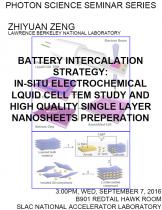Speaker: Zhiyuan Zeng, LBL
Program Description
Battery intercalation is the reversible inclusion or insertion of a molecule (or ion) into compounds with layered structures, which is really useful technique because rechargeable Li or Na ion batteries have an unmatchable combination of high energy and power density, making it the perfect energy storage of choice for portable electronics, power tools, and hybrid/full electric vehicles. The development of electrochemical liquid cell visualization method sheds lights on strategies of addressing batteries failures, improving batteries design and also enabling the next generation energy storage systems. Besides energy storage, battery intercalation can also be utilized as a strategy to synthesize high quality single layer nanomaterials.
In this talk, we are interested in failure mechanism study of Lithium/Sodium Ion Batteries at relevant length scale utilizing imaging and spectroscopy protocols. By developing a home-made electrochemical liquid cell TEM, we can directly vapture the dynamic electrochemical lithiation and delithiation of electrode in a commercial LiPF6/EC/DEC electrolyte, such as lithium metal dendritic growth, electrolyte decomposition, and solid-electrolyte interface (SEI) formation. This is a really useful technique in the battery field because it opened a venue by which to look inside the electrochemistry at unprecedented level, and thus improve electrode design for reducing short circuit failure and improving the performance of lithium/Sodium ion batteries. On material synthesis part, I will discuss how to design battery intercalation “environments” to obtain a serials of high quality single layer Transition Metal Dichalcogenides (TMD) nanosheets (MoS2, WS2, TaS2, TiS2 and ZrS2)- the Li insertion can be monitored and finely controlled in the battery testing system, so that the galvanostaic discharge is stopped at a proper Li content to avoid decomposition of the intercalated compounds; Moreover, the battery intercalation strategy was prove to be universal method by optimized the electrochemical lithiation conditions and we can extended this controllable lithiation process into BN, NbSe2, WSe2, Sb2Se3, Bi2Te3 and so on.
Bio
Zhiyuan Zeng received his Bachelor of Engineering in Materials Physics from the Central South University, China in 2006, and his Master of Engineering from Zhejiang University, China in 2008. He completed his PhD from Nanyang Technological University, Singapore in 2013. Zhiyuan moved to the in-situ liquid cell TEM group at Lawrence Berkeley National Laboratory as a Postdoc in February 2013. His primary research interest now is to use an Electrochemical Liquid Cell to develop imaging and spectroscopy protocols to elucidate the Electrode-Electrolyte Interface reactions for Lithium/Sodium ion Batteries.





